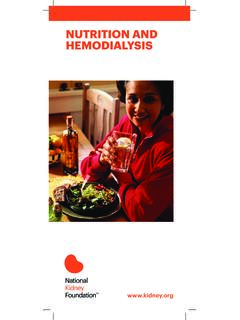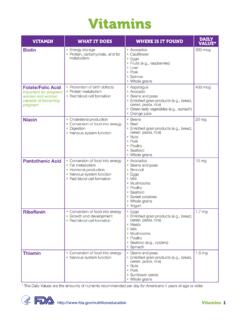Transcription of Vitamins and minerals: a brief guide
1 A Sight and Life publicationVitamins and minerals: a brief guideVitamins and minerals: a brief guideVitamins are organic nutrients that are essential for life. Our bodies need Vitamins to function properly. We cannot produce most Vitamins ourselves, at least not in sufficient quantities to meet our needs. Therefore, they have to be obtained through the food we eat. A mineral is an element that originates in the Earth and always retains its chemical identity. Minerals occur as inorganic crystalline salts. Once minerals enter the body, they remain there until excreted. They cannot be changed into anything else. Minerals cannot be destroyed by heat, air, acid, or mixing. Compared to other nutrients such as protein, carbohydrates and fat, Vitamins and minerals are present in food in tiny quantities. This is why Vitamins and minerals are called micronutrients, because we consume them only in small amounts.
2 Each of the Vitamins and minerals known today has specific functions in the body, which makes them unique and irreplaceable. No single food contains the full range of Vitamins and minerals, and inadequate nutrient intake results in deficiencies. A variety of foods is therefore vital to meet the body s vitamin and mineral requirements. Of the known Vitamins , four are fat-soluble. This means that fat or oil must be consumed for the Vitamins to be absorbed by the body. These fat-soluble Vitamins are A, D, E and K. The others are water-soluble: these are vitamin C and the B-complex, consisting of Vitamins B1, B2, B6, B12, niacin, folic acid, biotin, pantothenic acid and choline. Minerals are divided into two categories: macrominerals and trace minerals/trace elements. As implied by their name, macrominerals are required by the body in larger quantities (more than 100 mg daily) than trace elements.
3 To meet our requirements for some macrominerals we need to consume sufficient and varied food. The trace minerals are so named because they are present in relatively small amounts in the body. If we were to pool the requirements for trace minerals, they would produce only a bit of dust, hardly enough to fill a teaspoon. Yet they are no less important than the macrominerals or any of the other nutrients. The trace mineral contents of foods depend on soil and water composition and on how foods are processed. There are over two dozen minerals that are used by the body in various roles. In this booklet, we highlight only the minerals whose intake might become inadequate if access to a diverse diet is restricted. What are Vitamins and minerals?The history of Vitamins and minerals VitaminChemical name Year of discoveryWhoCountryFat-solubleVitamin ARetinol1913 Elmer McCollum and Marguerite DavisUnited StatesVitamin DCalciferol1922 Elmer McCollumUnited StatesVitamin ETocopherol1922 Herbert M EvansUnited StatesVitamin KPhylloquinone1929 Henrik Carl Peter DamDenmarkWater-solubleVitamin B1 Thiamin1897 Christiaan EijkmanNetherlandsVitamin B2 Riboflavin1922 UnknownUnknownVitamin B3 Niacin1936 Conrad ElvehjemUnited StatesVitamin B5 Pantothenic acid1931 Roger J Williams and R W TruesdailUnited StatesVitamin B6 Pyridoxine1934 Paul Gy rgyUnited StatesVitamin B7 Biotin1931 Paul Gy rgyGermanyVitamin B9 Folic acid 1941 Henry MitchellUnited StatesVitamin B12 Cobalamin 1926 George Whipple.
4 George Richards Minotand William MurphyUnited StatesVitamin CAscorbic acid1928 Albert Szent-Gy rgyiEnglandCholine 1862 Adolph StreckerGermanyMineralYear of discoveryWhoCountryMacromineralsCalcium1 808 Humphrey DavyEnglandMagnesium1755 Joseph BlackEnglandPhosphorus1669 Hennig BrandGermanyPotassium1807 Humphrey DavyEnglandTrace mineralsChromium1798 Louis Nicolas FranceVauquelinCopper9000 BCnsIraqFluoride1886 Henri MoissanFranceIodine1811 Bernard CourtoisFranceIron5000 BCns Selenium1817J ns Jacob BerzeliusSwedenZinc1746 Andreas MarggrafGermanyThe discovery of the concept of Vitamins A century ago, a Polish-American scientist attempted to isolate the first vitamin (B1) from rice bran. Casimir (born Kazimierz) Funk named his discovery vitamine , believing that this was an amine (nitrogen compound) vital for life. This coinage has come down to us in the slightly altered form of vitamin - even though most Vitamins were later shown not to be amines.
5 Funk s breakthrough discov-ery played a decisive role in the development of nutrition , which the world now takes for granted. Funk (1884 1967) was the first scientist to suggest the existence of an entire family of organic sub-stances essential for life, and the first to give these substances a name that made their function clear. In a distinguished scientific career spanning two world wars, Funk studied and worked in Europe and the United States. He had roles in academia and industry, and improved manufacturing methods for commercial drugs. Although he never received a Nobel Prize for his work, the Polish Institute of Arts and Sciences of America presents the Casimir Funk Natural Sciences Award annually to a Polish-American scientist. In 1921, the British biochemist Sir Jack Cecil Drummond suggested combining the use of letters of the alphabet with the term vitamin to denote a range of related organic micronutrients.
6 These nutrients consequently became known as Vitamins A, B, C and so and minerals in human nutritionWhile plants and micro-organisms can themselves produce the Vitamins necessary for the metabolism, humans and animals lost this ability during the course of evolution. Because they lack the enzymes necessary to make Vitamins in the body, humans and animals have to ingest them via the diet (with the exception of vitamin D, which is synthesized via the action of sunlight). Choline is the most recent addition to the group of essential nutrients. It was recognized more than 3,500 years ago that foods containing Vitamins are essential for health and well-being. The earliest records to have come down to us on this subject relate to the use of specific foods like liver which contains vitamin A to prevent diseases such as night blindness.
7 Nevertheless, the concept of Vitamins per se was quite unknown until very recently. Since the beginning of the 20th century, our knowledge of the function of Vitamins and minerals in our bodies has increased significantly. This understanding is reflected in the award of 20 Nobel Prizes in the vitamin field between 1928 and 1967. Only five percent of the weight of a human being is mineral matter. Yet minerals are vital for many bodily functions such as building bones, making hormones and regulating heartbeat. Minerals are indispensable for healthy growth and development. Most of the minerals in our diets come from plant or animal sources. Plants obtain minerals from the soil. Because soil mineral content varies geographically, the mineral content of plants will depend on where the plant grew and how much fertilizer it received.
8 Minerals may also be present in the water we drink, and this also varies with geographic location. AB5B7B12EB3B2 CKDB1B6 Vitamin A Eyes, immune system, skin, genes, growthVitamin D Skin (formed in), intestines, kidneys, bonesVitamin E Antioxidant, blood cells, stored in liver Vitamin KBlood (clotting)Vitamin B1 Energy metabolism, nerve and muscle activityVitamin B2 Energy metabolism, growth and reproduction, visionVitamin B3 Energy metabolism, neurological processesVitamin B5 Skin and hair, wound healing, blood lipid profileVitamin B6 Nerve activity, blood formation, DNAV itamin B7 Hair, nails, skin Vitamin B9 DNA synthesisVitamin B12 Nerve activity, neurotransmitters Vitamin CAntioxidant, iron absorption, immune system Choline Nerve activity, gene expressionVitamins and associated body functionsARetinol | CarotenoidsYear of discovery.
9 1913 Elmer McCollum and Marguerite DavisVitamin Vitamin A Retinol | CarotenoidsVitamin A plays a central role in our vision, skin, genes, growth, and immune system. It is especially important during the early stages of pregnancy in supporting the developing embryo. Infections and fevers increase the requirement for vitamin A. Three different forms of vitamin A are active in the body: retinol, retinal, and retinoic acid. These are known as retinoids. The cells of the body can convert retinol and retinal to the other active forms of vitamin A as needed. Each form of vitamin A performs specific tasks. Retinol supports reproduction and is the major transport form of the vitamin. Retinal is active in vision and is also an intermediate in the conversion of retinol to retinoic acid. Retinoic acid acts like a hormone, regulating cell differentiation, growth, and embryonic development.
10 Foods derived from animals provide retinol in a form that is easi- ly digested and absorbed. Foods derived from plants provide carotenoids, some of which have vitamin A activity. The body can convert carotenoids like -carotene, -carotene and -cryptoxanthin into vitamin A. The conversion rates from dietary carotene sources to vitamin A are 12:1 for -carotene and 24: 1 for -cryptoxanthin. The primary sources of vitamin ARetinol is found in liver, egg yolk, butter, whole milk, and cheese. Carotenoids are found in orange-flesh sweet potatoes, orange-flesh fruits ( , melon, mangoes, and persimmons), green leafy vegetables ( , spinach, broccoli), carrots, pumpkins, and red palm of vitamin A The bioavailability of vitamin A derived from animal sources is high about 70 90% of the vitamin A ingested is absorbed by the body.





